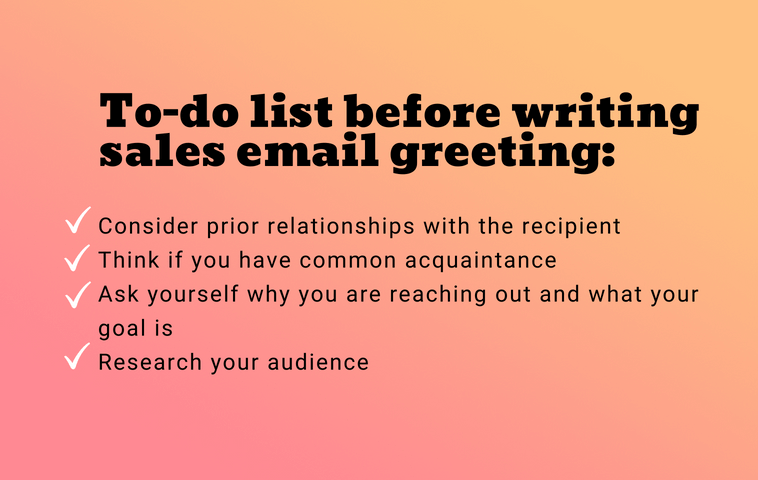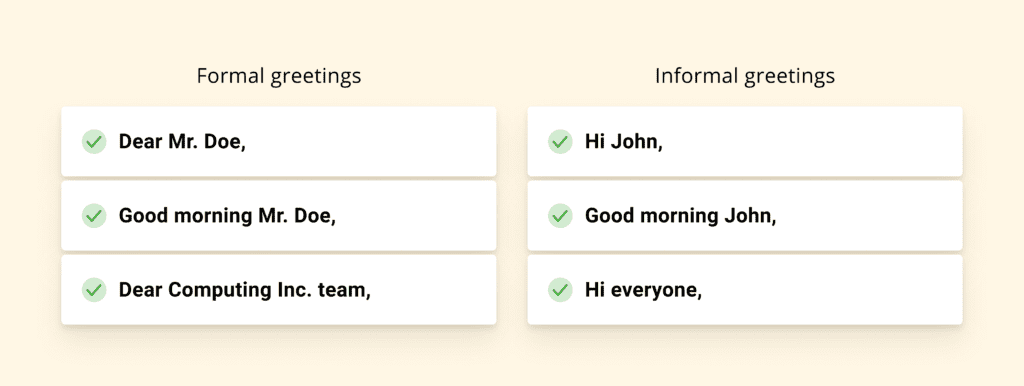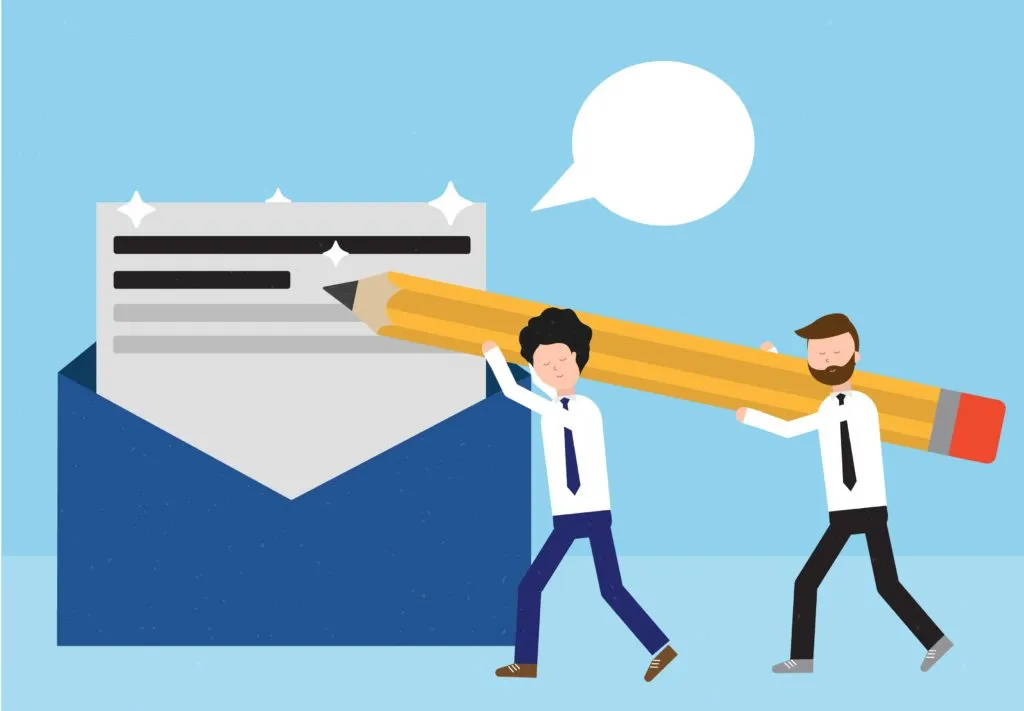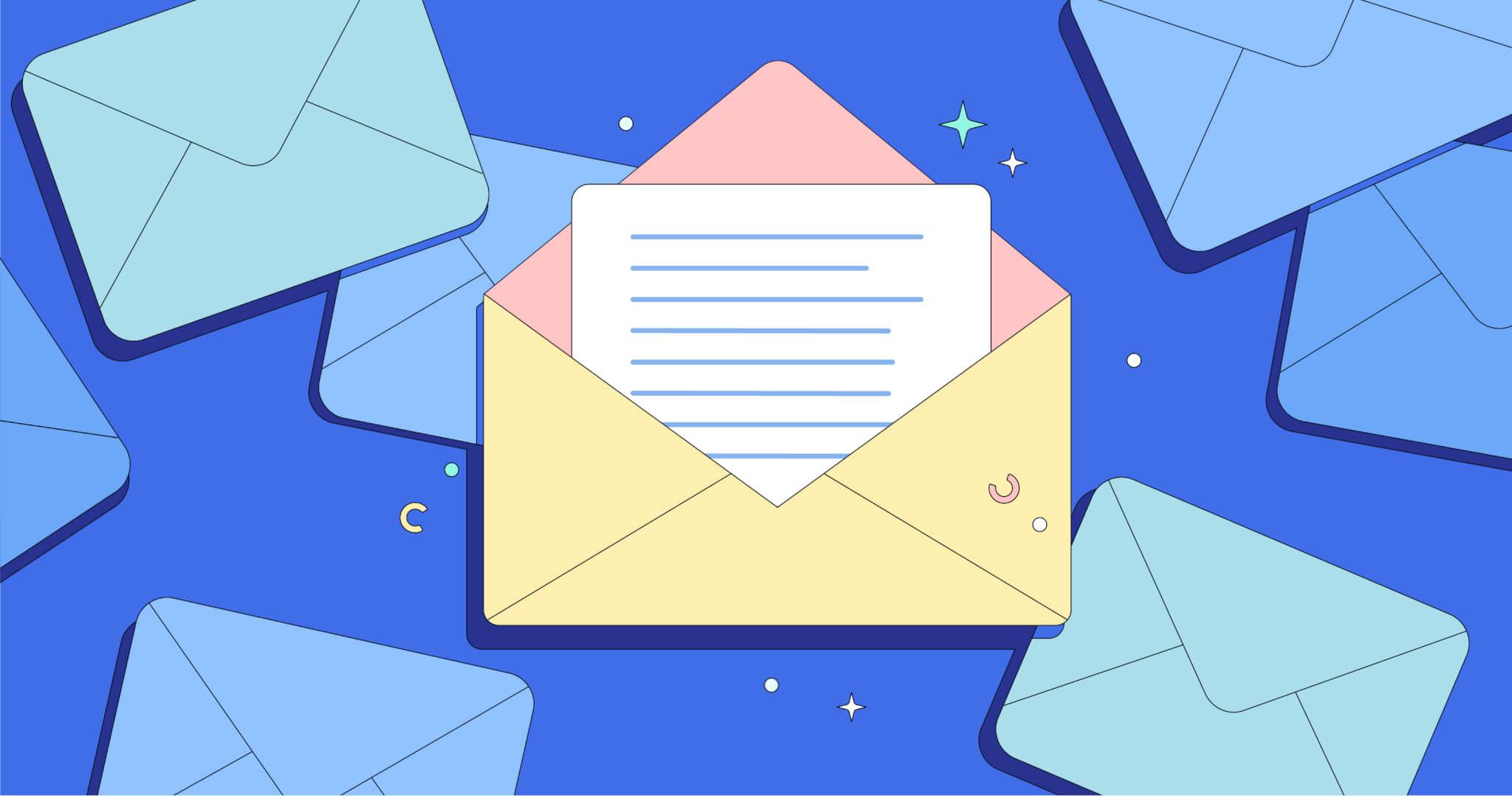Like everything else in digital marketing, email communication is changing, as well. People pay more attention to emails, they now can automate inboxing features, and filter out unwanted messages. Businesses can create templates to send a message to multiple recipients. Email marketing is evolving and requires an advanced approach to be noticed among hundreds of inboxed messages.
Writing memorable greetings and email openings has always been something that marketers value. They can have a powerful impact on the recipients’ perception and even decision-making. There is a lot of psychology research available on the effects of email openings and email greetings. Based on those research findings we built a guide that helps you choose email greetings and openings based on many different factors.
Why Does Everyone Use Emails
Email greetings may seem like a small and less important part of your message. But it is not true. They can play a decisive role in shaping professional communication. If you still doubt how greetings can change and shape your communication through email, have a look at these benefits:
- First Impressions: you cannot smile or give a handshake via emails. Email openings serve the same purpose as those two in-person meetings. Here you express your personality, your attitude, and professionalism. You can create a mood and set a positive beginning of a new business or personal relationship.
- Establishing Rapport: building rapport is part of email communications. It is not easy to achieve it, but email greetings can help you for sure. They help you show that you value the relationship. It also speaks a lot about your effort and investment.
- Reflecting Professionalism: In the professional world, greetings reflect your level of professionalism. An appropriate greeting demonstrates that you take your communication seriously and adhere to appropriate business etiquette.
Conveying Tone and Intent: greetings set the tone for the rest of the message. It does not matter if it is a formal or informal tone. The openings provide cues to the receiving person about the nature of your communication. It also sets your intention clear.
Aside from the obvious, there are some other reasons, such as:
In international communications, greetings can help you avoid issues due to cultural differences. There are different expectations and norms in various cultures. Hence, you need to think a lot about email openings when you get involved in cross-cultural communications.
By starting the conversation on a positive note, you set the stage for productive discussions and open communication, which can lead to better outcomes and stronger working relationships. It is a mistake to assume that a greeting is just a formality. They hold the secrets to effective negotiations, communications, and collaborations. It is worth taking your time to think cleverly about appropriate greetings and openings.
Why Context Matters


Email openings depend on a lot of factors. Context is the most important factor that everyone should consider before creating an email greeting. How you can decide what greeting to use based on context:
- Think about the nature of your relationship with the person receiving an email – is it your colleague? Your potential client? Someone you report to? Your employer? Or a person you interacted with before? How familiar you can be in your opening depends on how close you are to the person being addressed.
- Analyze the situation in which you are sending an email – is it to congratulate someone? Is it a single person receiving an email a team, or a group of people? Is it a work-related email or a personal one? These questions help you understand whether to send a formal and professional greeting or a friendly, informal, and casual one.
- What is the purpose and content of your email – are you updating your clients or partners on something? When was the last time you communicated with them? Is it a job application or an inquiry for service? All these things influence how you open your email.
- Keep in mind cultural differences – is the person you are sending an email to part of a different culture? How are your cultures different from each other? What are the customs in their region? How do these people say hi or greet each other? How much formality is required in their cultural communications?
Tips for Setting A Positive & Effective Tone in Your Greetings:


Your email openings set a tone. It is important to keep the same language, attitude, and degree of friendliness in the rest of your email content. Consistency in your email is very important. However, you set a tone with the greetings and openings.
- Be polite – always be polite, it does not matter if it is your friend, close co-worker, your boss, or a client. Remain respectful in every type of email communication.
- Keep it concise – there is no need to use lengthy greetings and openings if you can say it in short. Email communications should be kept very close to the point. Do not distract the addressed person from the main purpose of your email.
- Personalize only when appropriate – Personalized emails are not appropriate when you are sending a message to multiple people (even if you know all of them personally). Also, for example, with customer support inquiries, you rarely want to use personalized greetings. The simplest personalization is to use the recipient’s name. If you know the person well, you can include other messages, such as “Dear John, I hope you enjoyed your recent vacation”.
- Always use a professional tone – if it is a formal email or business-related message keep your tone formal. Do not use slang and jargon unless the other side is using it in communication. You can use “good morning”, or “good afternoon” for the formal greetings depending on the time of day you are sending an email
- Consider time sensitivity – if your email is urgent there are two things you need to do. First, indicate that the email is urgent in subject (so that the person opens it immediately), secondly, include the urgency notice in your email greeting. For example, “Dear John, I hope this email finds you well. I’m reaching out with an urgent matter that requires your immediate attention.”
- Be consistent – when you are communicating with the same individual several times keep consistency. Don’t change your email openings too often, however, you can personalize your emails more as time goes on.
Formal Greetings:
Formal greetings should be used in professional settings – with a lot of respect and a serious, professional tone.
For professional settings:
- “Dear [Name]”: everyone agrees on this greeting. It is a universally accepted form of opening an email. The only condition is that you must know the recipient’s name. Remember to use correct pronouns when addressing a person with Mrs/Mr. Don’t forget to use inclusive language best practices in all your email communications.
Example: “Dear Ms. Smith,” or “Dear John,”
- “Hello [Name]”: this is a bit more casual than “dear name”. It is often used in repetitive communications or quick replies. It also happens to be very appropriate to friendly, yet formal relationships.
Example: “Hello Dr. Johnson,” or “Hello Mr. Brown,”
- “Good morning/afternoon [Name]”: it is the most polite and nice opening out of these three. It acknowledges the time of day and is both friendly and formal at the same time.
Example: “Good morning, Ms. Thompson,” or “Good afternoon, Mr. Rodriguez,”
Suitable options for unknown recipients:
- “To whom it may concern”: it is the most common opening when you do not know the name or surname of a person being addressed. People use it often in job applications, service inquiries, or proposals.
Example: “To whom it may concern, I am writing to inquire about…”
- “Dear Sir/Madam”: it was used very frequently in the past. However, as inclusive language best practices appeared on the internet more recently, content specialists recommend that we do not use this greeting anymore. Example: “Dear Sir/Madam, I would like to express my interest in…”
Informal Greetings:
Informal greetings are way more flexible and you can spend less time thinking about how to open your email. However, these are for friendly atmospheres and communication with acquaintances or people you are close to.
Casual greetings for colleagues and acquaintances:
- “Hi [Name]”: This is a simple and commonly used greeting among colleagues and acquaintances. It’s casual and friendly while still maintaining a level of professionalism.
Example: “Hi Sarah,” or “Hi John,”
- “Hey [Name]”: This greeting is even more casual. It can be used in informal work environments or with colleagues you have a closer relationship with. But it does not mean you have to ignore work culture.
Example: “Hey David,” or “Hey Lisa,”
Greetings for close relationships:
- “Dear [Name]”: This is a common and universal greeting that can be used for both formal and informal emails. When used in an informal context, it indicates a level of familiarity and respect for the recipient.
Example: “Dear Alex,” or “Dear Emily,”
- “Hi [Name],”: This is a relaxed and friendly greeting. It is suitable for close relationships or when you want to create a warm and informal tone in your email.
Example: “Hi Sam,” or “Hi Michelle,”
The situation may be unforgiving if you become too friendly with a recipient that does not allow that level of familiarity. The safe choice is to keep your email openings and greetings a bit formal and wait for the respondent to start using familiar greetings.
Greetings for job applications and interviews:
– “Dear Hiring Manager”: This is a perfect greeting when you don’t have the specific name of the person responsible for hiring. It shows professionalism. Also, it indicates your intention to address the appropriate individual.
– “Dear [Specific Name]”: If you have the name of the hiring manager or interviewer, it’s best to use their name directly. This personalizes the greeting, but more importantly, demonstrates that you have done your research.
Greetings for client interactions:
– “Hello [Client’s Name]”: This is a friendly and professional greeting for client interactions. It acknowledges the client by name. Personal greetings with clients set a positive tone for communication.
– “Dear [Client’s Name]”: This greeting is slightly more formal and can be used when you want to convey a sense of respect and professionalism in your client communication.
Greetings for networking:
– “Hi [Contact’s Name]”: networking is a bit more friendly environment than business operations. You can use “hi” instead of good morning, or good afternoon, as these cases are more forgiving. When reaching out to a professional contact for networking, using a casual greeting like “Hi” can help create a friendly and approachable tone.
– “Dear [Contact’s Name]”: if you believe that your network contact is the more serious person you can use a more formal approach. Using “Dear” is always appropriate in all types of communication. Remember, you can always change your opening and greeting lines according to your recipient’s style of communication.
Greetings for follow-ups and thank-yous:
– “Dear [Recipient’s Name]”: When sending a follow-up or thank-you email, it’s best to use a polite and respectful greeting. Best practices tell us to address the recipient directly.
– “Hi [Recipient’s Name]”: If you have a closer or more informal relationship with the recipient, using “Hi” can create a warm and friendly tone for your follow-up or thank-you email.
Greetings for a New Connection:
– “Nice to meet you, [Name]”: if a person is someone you met recently or if it is your first time communicating with them use “nice to meet you, name” in your opening.
– “Thank you for connecting, [Name]”: This is a greeting we frequently see on social media or professional platforms, such as LinkedIn. greeting works well when reaching out to someone after connecting on a professional networking platform or receiving their contact information through a mutual acquaintance.
Greetings for a Referral:
– “Referred by [Referrer’s Name]”: When someone has referred you to a contact, mentioning the referrer in the greeting helps establish a connection and show your appreciation.
– “Recommended by [Mutual Connection’s Name]”: very similar to the first suggestion. If a mutual connection has recommended you to the recipient, mentioning their name in the greeting can create an immediate sense of familiarity and credibility.
Greetings for Collaboration Requests:
– “Hello [Name], I hope this email finds you well. I have an exciting collaboration opportunity to discuss with you”: This greeting sets a positive tone while immediately conveying the purpose and the potential benefits of collaboration.
– “Dear [Name], I have been following your work and am impressed by your expertise. I believe our skills align well and want to explore a possible collaboration”: This personalized greeting shows that you’ve done your research and are genuinely interested in collaborating based on mutual interests and expertise.
Greetings for Formal Apologies:
– “Dear [Recipient’s Name], I would like to extend my sincerest apologies for [specific situation]. I take full responsibility and deeply regret any inconvenience caused”: This formal greeting demonstrates accountability and shows that you are taking the apology seriously.
– “Hello [Recipient’s Name], I wanted to express my sincere apologies for [specific situation]. I genuinely value our relationship and want to make things right”: This slightly more casual greeting still conveys a genuine apology while maintaining a professional tone.
Remember, tailoring your greetings to specific situations helps establish relevance, personalization, and a clear understanding of the purpose of your writing.
Mistakes To Avoid In Your Email Greetings


When it comes to greetings, it’s important to avoid common mistakes that can undermine your professionalism and credibility. Here are some mistakes to avoid:
- Overly casual or informal language in professional settings: Using overly casual language like “Hey” or “What’s up” in formal or professional emails can be seen as unprofessional and disrespectful. It’s best to maintain an appropriate level of formality based on the context and the relationship with the recipient.
- Incorrect spelling or misusing titles: Double-check the spelling of the recipient’s name before sending the email. Misspelling someone’s name can come across as careless and unprofessional. Additionally, make sure to use the appropriate title (e.g., Mr., Ms., Dr.) when addressing someone, especially in formal or business settings.
- Using outdated or inappropriate greetings: Be mindful of using outdated or overly formal greetings that may not align with modern communication practices. For example, using “To whom it may concern” when you have the recipient’s name or using overly elaborate greetings can make it feel impersonal. Opt for greetings that are more concise, direct, and appropriate for the given situation.
- Avoid using greetings that may be considered inappropriate or offensive. Cultural sensitivity is essential, and it’s important to be aware of the norms and expectations of the recipient’s culture or professional environment.
Considering all of these, you can ensure that your greetings are professional, respectful, and appropriate for the given context. Taking the time to carefully consider your greetings demonstrates your attention to detail and enhances the overall effectiveness of your communication.





















Leave a Reply
View Comments